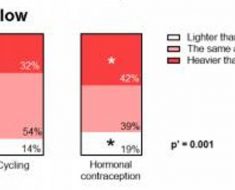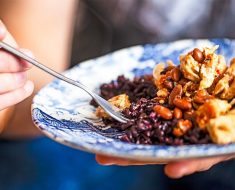In a recent study published in The American Journal of Clinical Nutrition, researchers assessed the dietary variations of tropical hunters and gatherers and the impact of the collection approach on implied macronutrient proportions.
 Study: Comparing Measured Dietary Variation Within and Between Tropical Hunter-Gatherers Groups to the Paleo Diet. Image Credit: VitaliiVodolazskyi/Shutterstock.com
Study: Comparing Measured Dietary Variation Within and Between Tropical Hunter-Gatherers Groups to the Paleo Diet. Image Credit: VitaliiVodolazskyi/Shutterstock.com
Background
Human nutrition differed considerably before the spread of agriculture; however, the Paleo diet has strongly impacted pre-agricultural nutritional perceptions.
The diet recommends percentage calories ranging between 19% and 35% for protein, 22% and 40% for carbohydrates, and between 28% and 47% for fats. In addition, the diet forbids the consumption of food items with added sugars, such as dairy products, cereals, legumes, and carbohydrate-dense tubes.
On the other hand, the empirical basis for the Paleolithic diet remains ambiguous, with some of its assumptions being questioned by archaeological evidence and theoretical fundamentals.
On the other hand, the empirical foundation of the Paleolithic diet remains a mystery, with its presumptions being challenged by archaeological evidence and conceptual fundamentals.
About the study
In the present study, researchers assessed the degree of variation among hunter-gatherer diets and investigated whether variations in collection methods accounted for differences in the inferred diets.
The team evaluated published data on hunter-gatherer diets, including information on honey, animal-based- and plant-based food consumption by kilocalories, and weight, from 15 ethnographic studies published with high-quality evidence for 11 hunter-gatherer tribes living in tropical regions.
Data from studies published in the Human Relations Area Files, Anthro Source, and Anthropology Plus databases on tropical (non-temperate, non-arctic) hunter-gatherer diets were analyzed.
Hunter-gatherers were classified as nomads that collected, extracted, and hunted wild plants and animals without engaging in gardening, animal husbandry, or agriculture. The studies included those in the Ethnographic Atlas with high-quality, quantified observational dietary data and excluded hunter-gatherers from arctic and temperate habitats.
The impact of annual mean temperature (AMT), season, and calendar year on hunter-gatherer diets was investigated for foods eaten in and out of camp areas.
The nutritional values of the food items were searched in United States Department of Agriculture (USDA) databases [Global Branded Food Products, Foundation Foods, and the National Nutrient Database for Standard Reference] and the Food and Agriculture Organization (FAO)/ International Network of Food Data Systems (INFOODS) Food Composition Database for Biodiversity.
Dirichlet regression modeling and Bayesian analyses were performed for inferences, including environmental factors and data collection approaches as model predictors.
Results
The analyses showed considerable variations in animal- vs. plant-sourced foods consumed and the corresponding proportions of carbohydrates, fats, and proteins. Additionally, studies weighing foods eaten within and beyond camp confines across years and seasons showed a greater intake of animal-sourced foods, varying with the AMT.
The findings, by weight, showed interquartile ranges (IQRs) of 41.0%, 35%, and 7.0% for animal-based foods, plant foods, and honey, respectively. The corresponding IQR values for kilocalories were 51%, 45%, and 13%, respectively.
Analyses of the diets of hunter-gatherers by kilocalories for carbohydrates, fats, and proteins showed that among the populations investigated, only a few had kilocalories in the ranges stated by the Paleolithic Diet. Hiwi, Jarawas, Onge, and Kunwinjku populations relied mainly on animal-origin foods, whereas plant-origin foods dominated the diet of San, Efe, Batek, and Nukak hunter-gatherers.
Honey comprised a minor portion of the diets across populations. Compared to the Paleo diet, the Nukak, Batek, Hadza, and Efe populations consumed higher proportions of carbohydrates, and the Onge, San, and Kunwinjku populations consumed more lipids.
The protein content of Nukak, Batek, and Efe hunter-gatherers was much lower than that of those who consumed Paleo diets.
Plant-origin foods provided 67% and 66% protein to the San and Nukak populations, respectively. In addition, 94%, 95%, 67%, 64%, and 50% of calories from dietary fat were derived from plant-based foods in the Nukak, San, Efe, Hadza, and Jarawas populations, respectively.
Among the Jarawas, Aché, Nukak, Efe, Hadza, and Batek populations, honey provided 37%, 57%, 20%, 33%, 21%, and 10% of caloric intake was derived from carbohydrates, respectively, and 61% of calories were derived from carbohydrates for the Kunwinjku population.
Total fat intake varied across tribes; however, the percentage of each type of fat was relatively constant. The number of calories provided by animal-based foods was not consistently related to the percentage of polyunsaturated to saturated fatty acids in the diet, indicating a broad range of lipid amounts and sources in the animal foods ingested.
AMT ranged from 21°C to 27°C across all groups. Honey intake was unaffected by temperature. Annual mean temperature and animal contributions to the diets of hunters and gatherers by kilocalories or weight had positive relationships.
Conclusions
Based on the study findings, hunter-gatherer meals vary widely, calling the conceptual "standard" pre-agricultural meal regarding macronutrient percentages or animal versus plant-based food proportions into question. A few tribes primarily consumed plant-based foods, whereas others mostly consumed animal-based ones.
While rainforest tribes (Batek and Nukuk) obtained few calories from animal-origin foods and consumed those with high carbohydrate and low protein, as well as lipid content, tribes residing in environments with greater openness (Onge and San) ingested a variety of animal-origin food items and nutrients such as carbohydrates, lipids, and proteins.
Groups also differed in their methods to obtain macronutrients, such as the Nukak and San tribes obtaining fat and protein mostly from plant-based meals and the Jarawas population deriving carbohydrates primarily from honey. Seasonal and yearly diversity was noted between both extremes.
-
D.E. Lieberman, S. Worthington, L.D. Schell, C.M. Parkent, O. Devinsky & R.N. Carmody., (2023) Comparing Measured Dietary Variation Within and Between Tropical Hunter-Gatherers Groups to the Paleo Diet, The American Journal of Clinical Nutrition, doi: 10.1016/ j.ajcnut.2023.06.013. https://ajcn.nutrition.org/article/S0002-9165(23)65975-1/fulltext
Posted in: Medical Science News | Medical Research News | Medical Condition News | Healthcare News
Tags: Agriculture, cAMP, Carbohydrate, Diet, Fatty Acids, Food, Honey, Lipids, Nutrients, Nutrition, Paleo Diet, Protein

Written by
Pooja Toshniwal Paharia
Dr. based clinical-radiological diagnosis and management of oral lesions and conditions and associated maxillofacial disorders.
Source: Read Full Article





